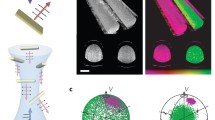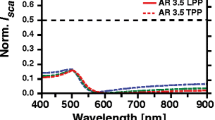Abstract
We introduce a novel method for single gold nanorods (GNRs) imaging by polarized light microscopy (PLM) based on their light depolarization light property. The results demonstrate that GNRs can be selectively seen by PLM, while sphere gold nanoparticles only can be observed under darkfield microscopy (DFM). When PLM is applied in single nanoparticle imaging, there are many outstanding features. For example, the average light spot of GNRs occupies 71 ± 26 pixels, which is only 42 % of that under DFM. The background is significantly reduced and signal-to-noise ratio is greatly improved by at least 3.6 times. Even GNRs in cells can be clearly detected with extreme low background, and the distributions of GNRs in the intracellular space were found to be ununiform. GNRs combined with PLM may find various uses in biomedical and clinical applications as well as in fundamental studies.



Similar content being viewed by others
References
Vigderman L, Khanal BP, Zubarev ER (2012) Functional gold nanorods: synthesis, self-assembly, and sensing applications. Adv Mater 24(36):4811–4841. doi:10.1002/adma.201201690
Huang XH, Neretina S, El-Sayed MA (2009) Gold nanorods: from synthesis and properties to biological and biomedical applications. Adv Mater 21(48):4880–4910. doi:10.1002/adma.200802789
Tong L, Wei Q, Wei A, Cheng JX (2009) Gold nanorods as contrast agents for biological imaging: optical properties, surface conjugation and photothermal effects. Photochem Photobiol 85(1):21–32. doi:10.1111/j.1751-1097.2008.00507.x
Papavassiliou GC (1979) Optical properties of small inorganic and organic metal particles. Prog Solid State Ch 12(3):185–271. doi:10.1016/0079-6786(79)90001-3
Pissuwan D, Valenzuela S, Cortie MB (2008) Prospects for gold nanorod particles in diagnostic and therapeutic applications. Biotechnol Genet Eng Rev 25:93–112. doi:10.5661/bger-25-93
Nikoobakht B, El-Sayed MA (2003) Preparation and growth mechanism of gold nanorods (NRs) using seed-mediated growth method. Chem Mater 15(10):1957–1962. doi:10.1021/cm020732l
Sau TK, Murphy CJ (2004) Seeded high yield synthesis of short Au nanorods in aqueous solution. Langmuir 20(15):6414–6420. doi:10.1021/la049463z
Chou CH, Chen CD, Wang CR (2005) Highly efficient, wavelength-tunable, gold nanoparticle based optothermal nanoconvertors. J Phys Chem B 109(22):11135–11138. doi:10.1021/jp0444520
Yorulmaz M, Khatua S, Zijlstra P, Gaiduk A, Orrit M (2012) Luminescence quantum yield of single gold nanorods. Nano Lett 12(8):4385–4391. doi:10.1021/nl302196a
Wang T, Halaney D, Ho D, Feldman MD, Milner TE (2013) Two-photon luminescence properties of gold nanorods. Biomed Opt Express 4(4):584–595. doi:10.1364/BOE.4.000584
Huang XH, El-Sayed IH, Qian W, El-Sayed MA (2006) Cancer cell imaging and photothermal therapy in the near-infrared region by using gold nanorods. J Am Chem Soc 128(6):2115–2120. doi:10.1021/ja057254a
Won Ha J, Sun W, Wang G, Fang N (2011) Differential interference contrast polarization anisotropy for tracking rotational dynamics of gold nanorods. Chem Commun 47(27):7743–7745. doi:10.1039/C1CC11679G
Chang WS, Ha JW, Slaughter LS, Link S (2010) Plasmonic nanorod absorbers as orientation sensors. Proc Natl Acad Sci U S A 107(7):2781–2786. doi:10.1073/pnas.0910127107
Eghtedari M, Oraevsky A, Copland JA, Kotov NA, Conjusteau A, Motamedi M (2007) High sensitivity of in vivo detection of gold nanorods using a laser optoacoustic imaging system. Nano Lett 7(7):1914–1918. doi:10.1021/nl070557d
Wang HF, Huff TB, Zweifel DA, He W, Low PS, Wei A, Cheng JX (2005) In vitro and in vivo two-photon luminescence imaging of single gold nanorods. Proc Natl Acad Sci U S A 102(44):15752–15756. doi:10.1073/pnas.0504892102
Khlebtsov BN, Khanadeev VA, Khlebtsov NG (2008) Observation of extra-high depolarized light scattering spectra from gold nanorods. J Phy Chem C 112(33):12760–12768. doi:10.1021/jp802874x
Wolman M (1970) On the use of polarized light in pathology. Pathol Annu 5:381–416
Massoumian F, Juskaitis R, Neil MA, Wilson T (2003) Quantitative polarized light microscopy. J Microsc-Oxford 209(Pt 1):13–22. doi:10.1046/j.1365-2818.2003.01095.x
Takanabe A, Tanaka M, Taniguchi A, Yamanaka H, Asahi T (2014) Quantitative analysis with advanced compensated polarized light microscopy on wavelength dependence of linear birefringence of single crystals causing arthritis. J Phys D Appl Phys 47 (28):285402. doi:10.1088/0022-3727/47/28/285402
Wolman M (1975) Polarized light microscopy as a tool of diagnostic pathology. J Histochem Cytochem 23(1):21–50. doi:10.1177/23.1.1090645
Ebner T, Omar S, Yaman C, Tews G (2009) A review of possible applications of polarization microscopy in IVF. J Turkish-German Gynecol Assoc. doi:10.1002/cm.970010302
Černý V, Turek Z, Pařízková R (2007) Orthogonal polarization spectral imaging. Physiol Res 56:141–147. doi:10.1159/000061948
van Turnhout MC, Kranenbarg S, van Leeuwen JL (2009) Modeling optical behavior of birefringent biological tissues for evaluation of quantitative polarized light microscopy. J Biomed Opt 14 (5):054018–054018. doi:10.1117/1.3241986
Aaron J, de la Rosa E, Travis K, Harrison N, Burt J, José-Yacamán M, Sokolov K (2008) Polarization microscopy with stellated gold nanoparticles for robust monitoring of molecular assemblies and single biomolecules. Opt Express 16(3):2153–2167. doi:10.1364/OE.16.002153
Saxton MJ, Jacobson K (1997) Single-particle tracking: applications to membrane dynamics. Annu Rev Bioph Biom 26(1):373–399. doi:10.1146/annurev.biophys.26.1.373
Rife JC, Long JP, Wilkinson J, Whitman LJ (2009) Particle tracking single protein-functionalized quantum dot diffusion and binding at silica surfaces. Langmuir 25(6):3509–3518. doi:10.1021/ la802144e
Szymanski CJ, Humphries IVWH, Payne CK (2011) Single particle tracking as a method to resolve differences in highly colocalized proteins. Analyst 136(17):3527–3533. doi:10.1039/C0AN00855A
Ni W, Kou X, Yang Z, Wang J (2008) Tailoring longitudinal surface plasmon wavelengths, scattering and absorption cross sections of gold nanorods. ACS Nano 2(4):677–686. doi:10.1021/nn7003603
Frens G (1973) Controlled nucleation for the regulation of the particle size in monodisperse gold suspensions. Nature 241(105):20–22. doi:10.1038/physci241020a0
Cao J, Galbraith EK, Sun T, Grattan KTV (2012) Effective surface modification of gold nanorods for localized surface plasmon resonance-based biosensors. Sensor Actuat B-Chem 169:360–367. doi:10.1016/j.snb.2012.05.019
Ruedas-Rama MJ, Walters JD, Orte A, Hall EAH (2012) Fluorescent nanoparticles for intracellular sensing: a review. Anal Chim Acta 751:1–23. doi:10.1016/j.aca.2012.09.025
Delehanty JB, Susumu K, Manthe RL, Algar WR, Medintz IL (2012) Active cellular sensing with quantum dots: transitioning from research tool to reality; a review. Anal Chim Acta 750:63–81. doi:10.1016/j.aca.2012.05.032
Xiao L, Qiao Y, He Y, Yeung ES (2010) Three dimensional orientational imaging of nanoparticles with darkfield microscopy. Anal Chem 82(12):5268–5274. doi:10.1021/ac1006848
Ueno H, Nishikawa S, Iino R, Tabata KV, Sakakihara S, Yanagida T, Noji H (2010) Simple dark-field microscopy with nanometer spatial precision and microsecond temporal resolution. Biophys J 98(9):2014–2023
Nieman L, Myakov A, Aaron J, Sokolov K (2004) Optical sectioning using a fiber probe with an angled illumination-collection geometry: evaluation in engineered tissue phantoms. Appl Optics 43(6):1308–1319. doi:10.1364/AO.43.001308
Jacques SL, Roman JR, Lee K (2000) Imaging superficial tissues with polarized light. Laser Surg Med 26(2):119–129. doi:10.1364/BOSD.2000.SuG2
Acknowledgments
This work was supported by the Natural Science Foundation of China (No. 81273002 and No. 81471499).
Author information
Authors and Affiliations
Corresponding author
Rights and permissions
About this article
Cite this article
Chen, Y., Chen, X., Cao, Q. et al. Selectively Imaging Single Gold Nanorods by Polarized Light Microscopy with Low Background. Plasmonics 10, 1883–1888 (2015). https://doi.org/10.1007/s11468-015-0011-6
Received:
Accepted:
Published:
Issue Date:
DOI: https://doi.org/10.1007/s11468-015-0011-6




